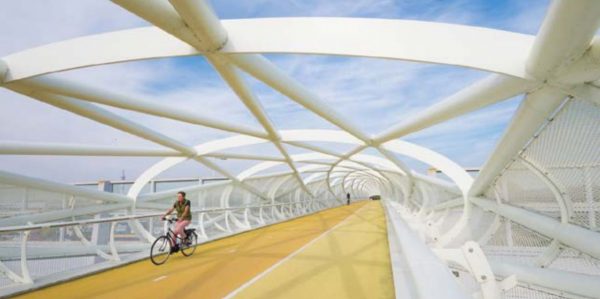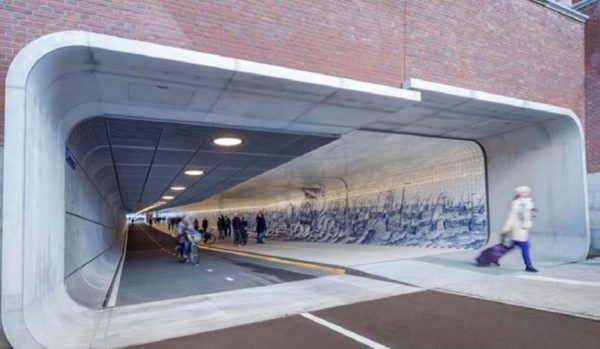A new way for pedestrians and cyclists to cross the Thames has long been planned, and now a consultation has opened on what sort of crossing we will get.
At the moment there is a chargable ferry that crosses the Thames at this spot, saving people living along the river at Rotherhithe the long walk/bus ride to the tube station at Canada Water. As the Jubilee line is as packed as a tin of sardines in the rush hour, a way of encouraging Rotherhithe residents to avoid the tube and cross over to Canary Wharf by another means is seen as a very good thing.
But quite how would they do that?
The ferry could be made free and made larger, but it waiting for the ferry(s) would slow the journey.
A bridge is the second cheapest option, but a low bridge needs to be opened a lot for ships, and a high bridge needs a lot of ramps for cyclists to get up to it.
A tunnel avoids all the problems – but costs a lot more.
TfL’s consultation recommends that a bridge be built at a cost somewhere in the region of £225-£300 million.
However, while TfL says that the cost of the tunnel is the most expensive option, the numbers actually look less worrying than the headline suggests.
The preferred option, of the bridge could cost at most £300 million, and would be expected to attract approximately 1.5 million pedestrian trips per year and between 450,000 and 900,000 cycling trips by 2031.
The tunnel would cost around £440 million, but would carry an estimated 1.6 million pedestrians and up to 900,000 cycling trips.
The financial figures are the total of all costs involved in designing, constructing, operating and maintaining that option over a 60 year appraisal period, reduced to 2016 prices.
That means that the bridge works out at £5 million per year, while the tunnel at £7.3 million per year.
The tunnel is also expected to have slightly higher usage, probably because it’s weatherproof and won’t be closed for shipping at random times.
| Pedestrians | Cyclists | Total user per year | Total over 60 years | Cost | Cost per trip | |
|---|---|---|---|---|---|---|
| Bridge | 1,500,000 | 675,000 | 2,175,000 | 130,500,000 | £300,000,000 | £2.30 |
| Tunnel | 1,600,000 | 900,000 | 2,500,000 | 150,000,000 | £440,000,000 | £2.93 |
Unlike the Greenwich/Woolwich tunnels, which are narrow tubes dug under the Thames, a tunnel at Rotherhithe could be based on wide concrete boxes being dropped into a trench in the river bed — so it would be considerably more appealing to use.
There also happens to be two very useful landing points for the tunnel — two disused docks that could offer gentle slopes to the street level.
On the Rotherhihe side, the dock wall is at street level, offering a convenient entry to the tunnel. On the Canary Wharf side, there would be a bit more complex, but the inlet dock could be a viable access point.
Once the sloping tunnel entrances are built, the docks can be reinstated above them again to hide the tunnel.
Bridges can, and often do, look quite lovely, but the cost difference, while not insignificant, is not so great that the tunnel should be overlooked. It would after all offer a dry route in winter and one that is not interrupted by ships needing to get past.
The consultation is here.










You have a small typo: “The preferred option, of the bride”. You can delete this comment after fixing the typo!
For “bridge” read “bride” throughout. Makes a more amusing narrative.
The advantage of the bridge is it becomes a tourist attraction in it’s own right, which a tunnel isn’t. I’d be curious to know how often it will need to open. I assume the bridge when closed is high enough for riverboats and smaller craft to pass under, only needing to open when something really big has to pass. So on an average day it might only be open once or twice? Equivalent would be the blinking eye bridge over the Tyne at Newcastle.
The consultation includes some information on predicted openings in Fact Sheet 3, based on surveys of boat movements in the area.
“initial findings suggest a bridge of 10, 15 or 20m above the water, during the busiest summer months, would open for an average 15, 8 or 4 vessels passing beneath per day respectively.”
They also say that an opening will mean the bridge is unavailable for between 10 and 60 minutes depending on the size of the vessel.
The actual impact on people wanting to cross will also depend on unknown factors such as how many of the openings will be for 10 minutes versus how many for 60 minutes, the times of day that the openings happen and what all those numbers look like in winter.
Ian
Has your view changed on the bridge since your similar post in 2009 regarding the Ramboll / Sustrans proposal? Is it based on aesthetics or convenience or a little bit of both?
The issue I potentially see with a tunnel, indeed both options, is that immediate access between the crossing and the riverside would likely be through lifts and or stairs as an accessible gradient would leave the landings inland or require an above or below ground spiral similar to the Ramboll proposal.
I think it’s clear that I still consider the tunnel to be the better of the options.
The access down to the tunnel is also going to be far less onerous than a bridge as the tunnel can be shallower than the bridge would need to be high.
A cable car would cost less than £100M, (Emirates was £60M on a wider stretch), would not close for river traffic, and would be a natural tourist attraction. One bike per gondola should be achievable.
Unfortunately, one bike per gondola would not be enough. The smaller 675,000 cyclists per year figure above works out to an average of 1,800 per day. Even if we spread these out evenly over the 16 operating hours of the day, that’s one every 30 seconds. i.e. Every gondola must have one cyclist in it to reach the expected numbers.
In reality, 50% of the cycle traffic would want to cross during two hours of each weekday. You would see 500 wanting to cross between 8am and 9am and that would require about 5 per gondola.
The 900,000 figure only makes this worse.
There are a handful of other drawbacks with a cable car.
1. It costs £3.50 to use. Over £10 without an Oyster card. Crossing a bridge costs nothing to the user.
2. It takes 10 minutes to cross compared to about 2 minutes on most bridges.
3. It’s only open between 7am and 11pm in summer and 9pm in winter.
4. It closes for regular maintenance and on Christmas day.
5. It closes for storms and high winds.
6. Wapping or Shadwell stations on the overground and Canary Wharf station on the DLR or Jubilee line are nearby existing options that are better than a cable car would be.
Almost no one uses the Emirates Skyway regularly. It’s only used by tourists. We want something that will be useful for regular commuters.
Why not run a transporter bridge, a la Newport or Middlesbrough? Allows people to get across at all times, provides a cycle crossing that avoids them having to get all the way up to 90 metres, and functions as a tourist attraction as well?
A bride is the second cheapest option, but a low bride needs to be opened a lot for ships, and a high bride needs a lot of ramps for cyclists to get up to it…
!! 🙂 lovely